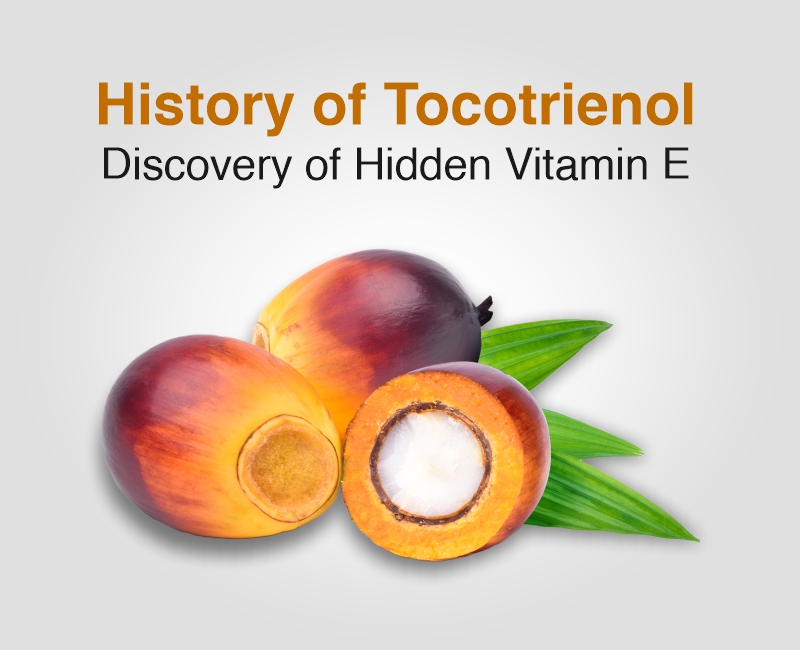Vitamin E has been the most revered product as an anti-oxidant. Natural anti-oxidants are gaining much traction in the Asia Pacific Region, with Vitamin E leading the guard. Tocopherols and Tocotrienols have been the most popular Isomers of Vitamin E on the Natural Anti-Oxidant platform.
Vitamin E is a group of eight fat-soluble compounds, including four tocopherols and four tocotrienols. Vitamin E is found in plant-based oils, fruits, vegetables, nuts, and seeds.
Some examples of Vitamin E sources are wheat germ oil, sunflower oil, almonds, peanuts, pumpkin, spinach – Palm and Annato, being the most potent sources for Tocotrienols.
What are tocotrienols?
Tocotrienols are a group of isomers that belong to the Vitamin E family. There are four variants of Tocotrienol, i.e., Alpha, Beta, Gamma, and Delta. This means tocotrienols are one-half of the vitamin E family tree.
Research has established that tocotrienols are far better than tocopherols in protecting the body from free radicals and oxidative damage. The behaviour of each form of Tocotrienol is different and offers a wide range of health benefits. Being an anti-oxidant, it has the power to reduce inflammation. It also has anti-ageing and anti-cancer properties.

O
Structure of Tocotrienols
Tocotrienols are named by analogy to tocopherols. Tocotrienols are “trienes“, which means they share an identical structure with tocopherols except for the addition of double bonds to their side chains. Tocotrienols have unsaturated isoprenoid side chains with carbon-carbon double bonds, while tocopherols have saturated side chains.
Both have four isomeric forms alpha, beta, delta and gamma. All tocotrienols have some physical antioxidant activity as they can donate a hydrogen atom to free radicals and reactive oxygen species.

Discovery of Tocotrienols
Tocotrienols were discovered a half-century ago, but most of their biology has been revealed in the last decade.
In 1922, Vitamin E was discovered by Evans and Bishop. Work in the 1930s disclosed the chemical structure and the biological function of alpha-tocopherol. Filer and others demonstrated that vitamin E protects tissue unsaturated fatty acids against oxidation.
In 2010, Dr Chandan K Sen, Dr Cameron Rink and Dr Savita Khanna worked together to find the activity of Tocotrienol in the brain and health diseases. The research highlighted the
benefits of Tocotrienol compounds, which were extracted from Palm oil, on neurological diseases and other health issues.
In 2010, Another study conducted by Lim Ai Beoy, Wong Jia Woei, and Yuen Kah Hay found that the administration of Tocotrienol increased hair numbers in volunteers suffering from hair loss. The possible explanation for the effects could be due to the potent antioxidant activity of tocotrienols that help to reduce lipid peroxidation and oxidative stress in the scalp, which are known to be associated with alopecia.
Sources of Tocotrienols
Natural tocotrienol sources include palm oil, coconut oil, rice bran oil, annatto, barley, and cocoa butter. Tocotrienols are also present in many fruits and plants. Palm fruit is considerably high in gamma, alpha and delta tocotrienols. Tocotrienol rich fractions(TRF) are used in anti-ageing, cosmetics, functional foods, and nutraceutical supplements.
Tocotrienols are safe and are well tolerated by the body, generally without any side effects. USFDA has given them the GRAS (Generally Recognized as Safe) status.
Conclusion
Tocotrienols are the most potent form of Vitamin E. They have proven to be 30 times more potent than tocopherols ( *1 ). The unsaturated bonds make it highly superior.
Natural Tocotrienols are gaining traction and are a SUPER INGREDIENT actively used in Cosmetics, Nutraceuticals and Food.




